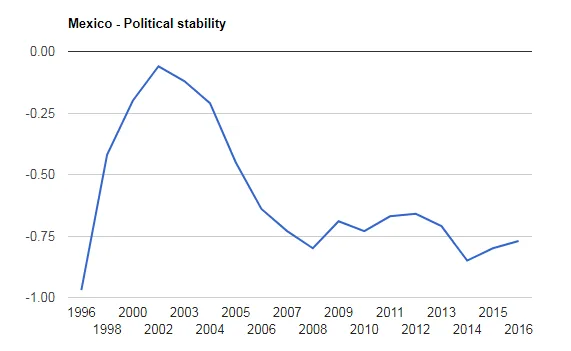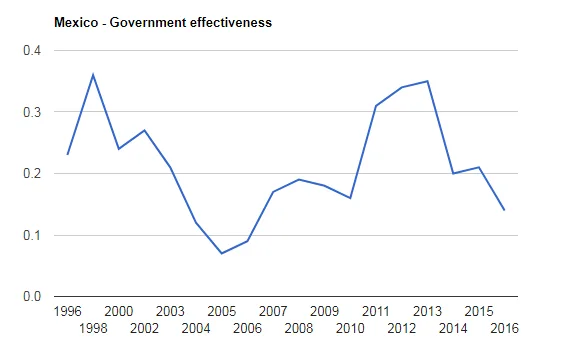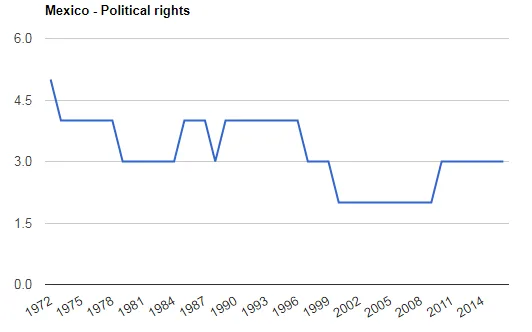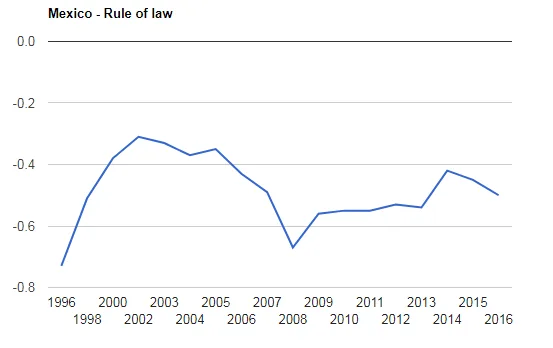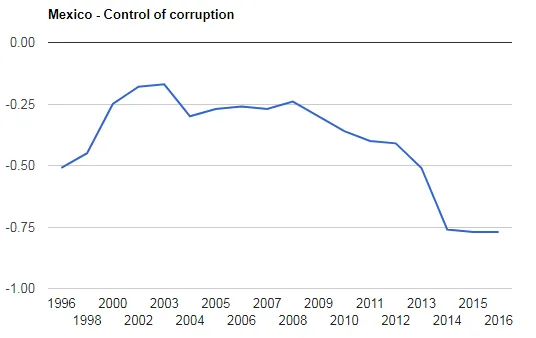Introduction
A strong governmental power can make a country strong and peaceful and bring economic growth. Opposite, a weak governmental power can make a country weak, unpeaceful, poor and even cause wars. Mexico is a country that has abundant resources, a high labor force, and an excellent location that is close to North America. On the other hand, at the same time, Mexico’s society is very unstable, high crime rate and poverty. People elect their government and wish the government can bring them stable, peaceful, and economic growth in the future. But, obviously Mexican government do not do that, the drug violence, human trafficking, and gun smuggling problems are still there [1]. According to the research, drug violence area is spreading even though the drug violence rate has declined along the US – Mexico border, but in the south of Mexico, it is increasing[2] . The Mexican government also has corruption problems; it makes people untrusted their government and public institutions. Then, the governors are getting harder and harder to do their tasks [3]. In this research paper, I want to discuss what happened to Mexico’s government and its governmental power. The government should give their people a stable life without war, but Mexico’s government failed to do that. What is wrong with Mexico’s governmental structure? The paper aims to examine the factors that affect the stability of the government structure.
Discussion
Legislative Structure
The legislative branch of the Mexican government consists of two divisions, upper and lower. The top division is the Senate, and the lower division is the Chamber of Deputies. By comparing these divisions with the divisions of the USA, both have the same purposes: approval of legislation and ratification of upper-level presidential appointments. In practice, the executives initiate around 90% of all laws. Every year, Congress holds two sessions. The first session starts and ends in the period of November 1 to December 31. However, the second session begins and ends between the period of April 15 to July 15. Thirty-seven members of a permanent committee assume the legislative responsibilities during congressional recesses. In the past, the Senate consisted of 64 members. From these sixty-four members, two members appointed will represent the federal district, and two will be selected for each state of the country. The term for these appointments used to be six years. In 1193, the size of the Senate doubled, with the members of a total of 128. After 1986, lower division of the government consisted of 500 members, from these 500, 200 were selected by the representatives of different districts.
The primary power of Congress includes the right to impose taxes, pass laws, approve the national budget, declare war, conventions made with foreign countries and approval or rejection of treaties. The lower division of the government is similar to the US House of Representatives, which identifies all issues that are more closely related to the government’s budget. Deputies of the chamber have the power to elect the provincial president. Every legislative council has its committee that examines and proposes bills. However, if there is any conflict arises between the chambers, then a compromised version of a draft will be given by the joint committee.
Judicial Structure
In the Mexican government, the Judicial system is divided into state and federal systems. The highest court of Mexico is the Supreme Court of Justice. It consists of 21 magistrates along with five auxiliary judges. The president appoints these members and is approved by the parliament or Senate committee. Eligibility criteria a straightforward person should be a Mexican citizen, must be an age of between 35 to 65 years and should have a law degree. Mexican constitution explains that the appointment of judges is for a lifetime; however, it can be replaced by the Chamber of Deputies. The meetings of these judges vary with the nature of the cases. One argument that is raised on the judicial system is based on the fact that the judicial system for big giants is different from the judicial system for average or poor people of Mexico. This raises the question of the fairness of the judicial system. One of the articles published shows the unfairness and avoidance of public appeals in the judicial system in Mexico. Although amendments are made in the judicial system to make it fair in all aspects to reach its fairness, it will take more than 11 years to incorporate pure and fair justice in society [4].
The judicial system presented by the government depicts its fairness, but in reality is way too different. Another study reveals that the crime rate is increasing at high speed in Mexico, but the government has failed to stop that crime. Even the judicial system that should punish the criminals has its eyes closed on these matters, and its reforms are in great danger. However, new reforms have been provided. For instance, in 2008, the Congress of Mexico approved a series of reforms that established adversarial court proceedings and effective legal protection for criminal defendants. However, these reforms were not successfully implemented; if it does, then the crime rate should have been reduced rather than going up [5].
According to the article 155 of the criminal code in the judicial system explains the use of bracelets and ankles to measure eth precautionary measure of a risk person. Although this is mentioned in the constitution, there are still no prisons that have such tools. There is no evidence that the prisons are using these. Precautionary measures are still not prevailing in Mexico, which should have been. According to the director of the Criminal Procedural Justice Institute, there is a need to strengthen precautionary measures [6].
There are many cases reported and published in the media of Mexico that represent the poor and unfair treatment of the courts to innocent people. For any government, the judicial system plays the role of a backbone. In past times, Mexican trials were conducted on the basis of writing, witnesses, with victims, and it has been seen that lawyers don’t have access to the judge now; this is the system that will presume guilt over innocence, which ultimately gives the prosecutor a vast power [7].
State Government
Mexico has 31 states and a federal district that encompasses Mexico. Every country in Mexico has its constitutions that are modeled on the national charter. At the national level, both the state and local government have their executives and judicial branches. The primary function of the state government is to legislate and levy taxes on customs duties. Other than the fact that the political system of Mexico is highly centralized, which means that all the decisions are made at the central hub of the government. The state government is mostly dependent on the revenues from Mexico City. The governor is the one who handles the executive branch of the state. The majority votes directly elect a governor for a term of six years. Just like the president, the governor cannot be reelected. Most of the legislative bills are represented by the deputies, the state superior court of justice and by the state governor. However, in some cases by the municipality within the particular state. The Supreme Court of Justice heads the state judiciary. The federal district has its local courts and representative assembly, which is elected by proportional representation. In the past, the assembly was considered a local body that didn’t have any legislative power.
Local Government
Local government is considered one of the basic units of the Mexican government. There are more than 2000 municipal governments in Mexico. These governments are mainly responsible for multiple public services that include street lighting, water and sewage, public safety and traffic, maintenance of parks and cemeteries and cleaning and maintenance. Every municipal government is run by the mayor, who is selected for a term of 3 years. Local governments are authorized to collect taxes, but they have failed to do so in the past. Municipality governments are free to assist state and federal governments associated with the issue is education, medical services and emergency fire [8].
Following are some graphs taken from the World Bank statistics that show the effectiveness of the political system in Mexico along with corruption, the rule of law and government effectiveness.
Source: World Bank
The above chart shows the political stability of Mexico. The parameter ranges from -2.5 to 2.5, in which -2.5 shows weak political stability while 2.5 shows strong political stability. The data are taken from 1996 to 2016. One can see that from the period of 1996 to 2016, there was no single year in which the country’s political position went to stability. It is always in a negative figure.
The graph presented above shows the effectiveness of the Mexican government from the period of 1996 to 2016. This chart shows that the government was found useful in 1998 with 0.35 points, but after 1998, it dropped down in coming years until it rose again in 2013 and 2014. However, in 2016, the World Bank gave the effectiveness points of 0.15, which shows the moderate effectiveness of the government. The efficiency of government is associated with the quality of civil services, the quality of public service and the degree of its independence from political pressures.
The graph shown above shows the effectiveness of political rights in Mexico. The range standard was from 1 to 7 points, in which 1 indicates weak political rights while 7 shows strong political rights. This index measured the data from 1972 to 2014; the average value for Mexico is 3 points, while it was high in 1972 with 5 points. Three categories have been evaluated in measuring the political rights index: political pluralism, participation and electoral process. From the graph, one can say that in the start, Mexico had strong political rights provided, and with the passage of time, it dropped down to 3 points in 2014, which shows the inefficiency of rights.
The above graph shows the index rule of law from 1996 to 2016. In the figure -2.5 shows the weak rule of law while 2.5 shows the strong rule of law. The index captures the perception to the extent to which agents have confidence and trust in and abide by the rules of society, property rights, the courts, the police and the likelihood of crimes. The average value for Mexico in the defined period was -0.48 points, which shows the weak rule of law in Mexico.
The graph shown above represents the control of corruption by the government of Mexico from the period of 1996 to 2016. -2.5 shows weak efforts, while 2.5 shows strong efforts by the government in the reduction of corruption in the country. The average value for corruption control is -0.48 points, which means the government was inefficient in reducing corruption in the country. The index captures the perception of the extent to which the top officials of the government exercise public power for their private gains and motives [9].
References
- Morris, Stephen D. Corruption & politics in contemporary Mexico. University of Alabama Press, 1991. ↑
- . Molzahn, Cory, Viridiana Ríos, and David A. Shirk. “Drug violence in Mexico: Data and analysis through 2011.” Trans-Border Institute, University of San Diego, San Diego (2012). ↑
- Morris, Stephen D., and Joseph L. Klesner. “Corruption and trust: Theoretical considerations and evidence from Mexico.” Comparative Political Studies 43.10 (2010): 1258-1285. ↑
- Mexico has spent eight years overhauling its dysfunctional justice system, but it may need 11 more to fix the mess. 2018. “Mexico Has Spent 8 Years Overhauling Its Dysfunctional Justice System, But It May Need 11 More To Fix The Mess”. Business Insider. Accessed April 23, 2018. http://www.businessinsider.com/mexico-needs-11-more-years-to-reform-justice-system-2016-5. ↑
- SHIRK, OCTAVIO. 2018. “Mexico’s Badly Needed Justice Reforms Are In Peril.” Sandiegouniontribune.Com. Accessed April 23, 2018. http://www.sandiegouniontribune.com/opinion/commentary/sd-mexico-justice-utak-commentary-20170811-story.html. ↑
- “Six Shortcomings Of Mexico’s New Justice System.” 2017. Insight Crime. Accessed April 23, 2018. https://www.insightcrime.org/news/analysis/six-shortcomings-of-mexico-new-accusatory-criminal-system-according-to-experts/. ↑
- “In Mexico, A Justice System Where ‘Citizens Are Heard’ Starts To Take Root.” 2016. The Christian Science Monitor. Accessed April 23, 2018. https://www.csmonitor.com/World/Americas/2016/0601/In-Mexico-a-justice-system-where-citizens-are-heard-starts-to-take-root. ↑
- “Mexico – Government Structure.” 2018. Countrystudies.Us. Accessed April 23, 2018. http://countrystudies.us/mexico/82.htm. ↑
- “Mexico | Data.” 2018. Data.Worldbank.Org. Accessed April 23, 2018. https://data.worldbank.org/country/mexico?view=chart. ↑
Cite This Work
To export a reference to this article please select a referencing stye below:

